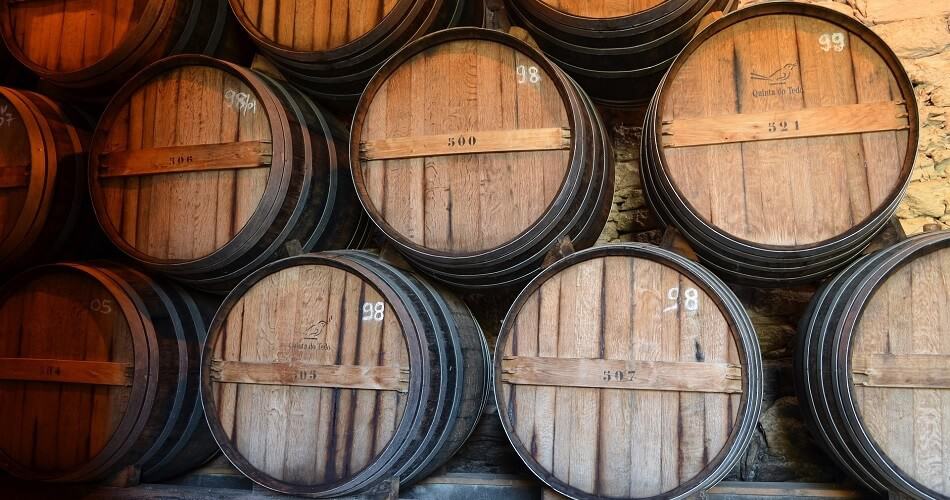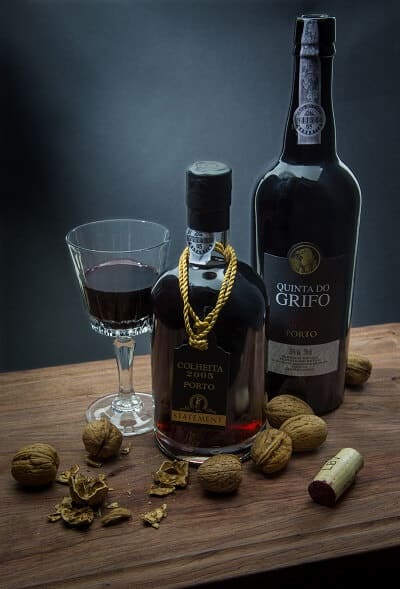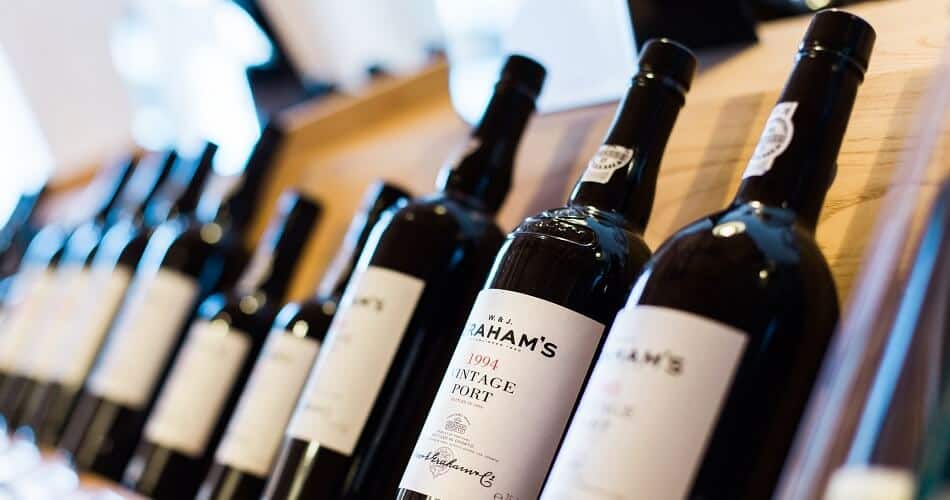Port wine is a fortified wine from Portugal. Most styles are sweet and made of red grapes. But there are also dry styles as well as white and rosé Port wines. As Port wine is fortified with neutral brandy, it has an alcohol content of around 20%.
Port wine is very versatile, and there are many different styles that vary in color, taste, and sweetness. To understand their differences, how they are made, and how to enjoy them best, keep on reading.
WHERE DOES PORT WINE COME FROM?
Port wine has its origin in the Douro valley in the northern part of Portugal. The grapes for producing it grow on terraces on the banks of the Douro river and its tributaries. With mountains surrounding the area and protecting it from Atlantic winds, the Douro Valley typically has hot and dry summers and cold winters.
With regional winemaking dating back to the 3rd and 4th centuries, the Douro Valley is a UNESCO World Heritage Site. Furthermore, it has earned the label “Denominação de Origem Controlada” (English: controlled denomination of origin), which indicates high-quality wines.

Wine Terraces in the Douro Valley, Portugal
The History of Port Wine
Since the 17th century, Port wine has gained international popularity. The main reason was the increasing demand from the British. The rough British climate prevented them from growing wine in their home country. So they were dependent on imports from France to fulfill domestic demand. And when military conflicts led to a boycott of French products, the British turned to Portugal to import their wine.
Unfortunately, wine often didn’t survive the long journey from the inland wineries via the coast of Portugal to the British islands. Thus, some smart British merchants started to add neutral-tasting brandy to the wine to maintain its quality during the trip. That is how Port wine was invented.
In the following years, a division of labor was established to produce Port. While the Portuguese grew the grapes in the Duoro Valley, the British produced and aged the wine in the coastal city of Porto. The city name also is the origin of the wine’s name, “Port”.
In the 19th century, Port wine production almost came to an end. An insect infestation and pest removal attempts with strong chemicals ruined the soil in many vineyards. Today, you can still find abandoned properties that never recovered from this disaster.
WHAT IS PORT WINE MADE OF?
Portuguese vintners use numerous types of grapes to make Port wine. The total number of varietals ranges from 50 to more than 80, and many are unique to Portugal.
The most common varietals for Port wine production are Touriga Nacional, Touriga Franca, Tinta Barroca, and Tinta Roriz. All of them are small red grapes with thick skins that can withstand the hot, arid climate of the Duoro Valley. But they all have unique flavors.
Besides, white grapes such as Sercial, Malvasia Fina, or Verdelho also are used to produce Port.
HOW PORT WINE IS MADE
Usually, the harvest for Port grapes takes place in mid-September. Many winemakers still pick them by hand because they can’t access the narrow terraces with tractors. Next, they inspect the grapes and place them in “lagars”. These are shallow open containers made from stone, concrete, or -in rare cases- granite.
Traditionally, winemakers stomped the grapes by feet. Soon after, the fermentation started while the workers stirred the must with long wooden plungers called “macacos”. Nowadays, only a few wineries stick to manual methods. Most use mechanical processes to crush and ferment the grapes. No matter the technique, the fermentation process takes up to three days.
When the sugar level gets to the ideal level, the winemakers extract them from the lagars. Then, they fortify it with up to 30% neutral-tasting brandy. This spirit stops the fermentation process to preserve some of the grapes’ natural sweetness.
After the fortification, Port wine ages in large oak barrels, called “balseiros”, or in steel containers that help maintain its initial flavors. Alternatively, the aging takes place in smaller barrels (“pipas”). They expose the wine to higher levels of oxygen and cause the development of more nutty aromas. Winemakers rotate the wine regularly to achieve an ideal balance of character.
According to Portuguese wine law, the aging process of Port wine takes at least two years. But even after this time, winemakers can only sell 30% of their vintage. In other words, the government forces them to age at least 70% of their wine longer. For this extended aging, some wines are transferred into bottles, while others stay in oak casks.

Port Wine Barrels in a Portuguese Winery
DIFFERENT TYPES OF PORT WINE
There are many different types of Port wine. They differ by the production process, color, age, and taste.
Ruby Port is the youngest type as it ages for only three years. Its name origins from its color. Typically, winemakers use a mix of different varietals as well as different vintages to make Ruby Port.
Reserve Port is a blend of different wines of decent quality. It ages a little longer than Ruby wines, making it a richer, more creamy wine. To earn the right to carry the Term “Reserve” (“Reserva” in Portuguese), an official tasting panel called “Camara de Provadores” needs to approve and certify the wine.
Tawny Port wines are made from red grapes of different vintages. As the name suggests, they are of light brown color from long aging in small wooden casks. During this process, Tawny develops a mellow and vibrant character, nutty aromas, and incredible sweetness.
Reserve Tawny Port ages for at least 7 years. If it spends 10 years in a cask before bottling, it carries this number on the label instead of the term “Reserve” (or “Reserva”). The same goes for wines that age for 20, 30, or 40 years.
Colheita Port is a single-vintage type of Tawny Port. It ripes for at least seven years in casks. Typically, you can find two dates on the label of a Colheita bottle: the year of the harvest and the bottling year.
Vintage Port is the best-quality and most-structured type of Port. Like Colheita, it is a single-vintage wine blended from the best grapes from multiple vineyards. As the quality of grapes doesn’t match the standard for Vintage Port in some years, it’s rather rare. Vintage Port remains in casks for only six months to two years. But after that, it ages in bottles for decades without being filtered.
Single Quinta Vintage Port is a Vintage Port wine made from grapes harvested in one single vineyard.
Vintage Character Port is a blend made from more than one vintage. Vintners compose it to taste like a single vintage, though.
Late Bottled Vintage Port (LBV) remains in oak barrels for four to six years before bottling. Some vintners age LBV wines in bottles afterward, but this isn’t a requirement to carry the label Late Bottled.
Crusted Port is a blend of wine from two or three different years. It ages in oak casks for up to two years. The name Crusted Port derives from the sediment that results from bottling the wine without any filtration.
White Port is of Golden color and typically less sweet than red types. However, it can range from very dry (“Extra Seco”) to dry (“Seco”) to sweet (“Doce”) to very sweet (“Lágrima”). Vintners produce it from white grapes and bottle it after two to three years of aging in barrels.
Reserve White Port is a white style that ages for a specific number of years. You can usually read the exact age on the bottle label.
Garrafeira Port is a very rare type of Port wine. It is a single-vintage wine that ages in wood for three to six years. After that, the wine ripes further in glass demijohns, often for decades. The direct contact with the glass gives this type a very smooth and unique character.

Bottles of Colheita Port (left) and LBV Port (right)
WHAT DOES PORT WINE TASTE LIKE?
In general, Port wine is sweet and strong in alcohol. Its taste depends on its style and age, though:
- Ruby Port typically comes with intense sweet fruity flavors of red berries, cherries, blackcurrant, and chocolate notes.
- Tawny Ports, on the other hand, develop aromas of caramel, almond, or nuts. They tend to be even sweeter than Ruby Port.
- White variations often have citrus flavors. You can taste green apples or apricots, and in older wines, also roasted nuts.
- Old Vintage wines often are much more complex. They develop more intense nutty flavors, aromas of vanilla and dried fruit, and floral or spicy notes.
You can also find dry variations, but these are rather rare.
HOW TO SERVE PORT WINE
Being a sweet and strong wine, Port wine should be served in small portions of about 3 oz (75 to 100 ml). It’s great as an aperitif before the meal (especially white Port) or as a digestif afterward. On a warm summer day, you can drink it on the rocks. But you should only do so with low-cost wines. Ice will dilute the flavors of an expensive Vintage Port and harm your drinking experience.
Both white and red styles can also be an ingredient for delicious port wine cocktails.
What Is the Right Glass for Port Wine?
As Port wine comes in small portions, the ideal glasses are rather small compared to regular wine glasses. They have medium-long stems and small bowls to keep the alcohol from overpowering the wine’s aromas.
If you don’t have Port glasses, you can use other dessert wine glasses or regular white wine glasses.
What Is the Right Serving Temperature for Port Wine?
You should serve Port wine slightly chilled so that it’s just below room temperature. Aim for 57 to 59°F (14-15°C). To bring it down to this temperature, put the Port bottle in the refrigerator for 30 to 60 minutes. Vintage Port is an exception. For these old wines, room temperature is fine so that they can release all of their aromas.
Should You Decant Port Wine?
You can decant Port wine, but in most cases, it isn’t necessary. Only if a bottle has the word “unfiltered” on its label should you absolutely decant it before serving. That’s usually the case for older Vintage Ports because they can contain sediment in the bottle. To get rid of it, store the bottle standing upright for a couple of hours before opening it. When pouring the wine into the decanter, make sure to leave the sediment in the bottle. Alternatively, you can use a decanter with a sediment filter.
HOW TO STORE PORT WINE
Store Port wine in a cool and dark location. As long as you don’t open it, you shouldn’t put it in the refrigerator. A rack in your cellar with a steady temperature is perfect.
If the bottle has a cork cap, it should lay on its side, so the cork doesn’t dry out. If not, you can also store it standing up.
Vintage Ports should always lie on their sides, just like table wines. Ruby and Tawny Ports are ready to drink once released and can either be stored upright or on their sides.
Can Port Wine Be Aged?
Some Port wines can be aged, but others can’t. Ruby and Tawny Port (including Reserve and Colheita wines) are ready to drink as soon as you buy them. They won’t get much better if you store them for a long time. Vintage Port, on the other hand, has enormous aging potential. The longer you put it into your cellar, the more its tannins will soften and the more complex aromas it will develop.
The bottle cap gives you a hint about the wine’s aging potential: A regular long cork is an indicator of a wine with aging potential. A cork cap topped with plastic means that you should drink the wine soon.
Can Port Wine Go Bad?
Port wine can go off when exposed to oxygen. The vulnerability of a wine depends on its aging process: Port that ages for many years in oak barrels is used to being exposed to oxygen. Thus, it won’t go bad as soon as a wine that spent only a little time in wooden casks.
Can Port Wine Be Corked?
Port wine can be corked just like any other wine in a cork-sealed bottle. If the cork dries out, small pieces of it may contaminate the wine. For this reason, Vintage Port with cork caps should always lie on its side.
How Long Does Port Wine Last When Open?
Thanks to the added brandy, Port wine will last much longer than regular table wine after opening the bottle. If you recap the bottle, you can store most types for at least two to four weeks at room temperature. To keep them longer, put them into the refrigerator. That can slow down the oxidation process, which causes the wine to go bad. A chilled Port wine stays fresh for up to three months.
However, there are exceptions: Vintage Port that doesn’t age for a long time in barrels goes off much faster than Ruby or Tawny wines that spend decades in oak casks. So drink Vintage Port, especially if it’s very old, soon after opening it.
WHICH FOOD GOES WITH PORT WINE?
When serving Port wine with food, you can follow one of two general approaches:
- Serve it with a sweet dish, but not with one that is sweeter than the wine.
- Create an interesting contrast by serving a sweet Port with a salty dish.
Following these rules, you can serve Port as an aperitif with salty bits like olives or almonds.
As a dessert wine, you can pair it with tarts and chocolate-based dishes. Besides, Tawny Port is great with nut- or fruit-based pies, cheesecake, or tiramisu, but also spicy hard cheeses. Vintage Port is a delicious match for blue cheeses.
Finally, you can also sip Port with snacks like pretzels, nuts, or crackers.
SHOPPING PORT WINE
If you want to buy traditional Portuguese Port wine, you have to pay special attention to bottle labels. Only a wine that actually comes from the Douro Valley may carry the term “Porto” on its label. Wines that don’t have this label come from other countries, such as South Africa. Although these can provide pleasant experiences, they often lack the characteristics of the Portuguese original.
As your first Port wine, go for a basic Ruby or Tawny Port. These wines are affordable and approachable, so they are a good entry into the world of Port. Try, for instance, these wines:
- type: red, fortified, sweet
- origin: Portugal, Douro
- varietal: Touriga Francesa, Touriga Nacional, Tinta Amarela, Tinta Barroca, Tinta Cão, Tinta Roriz
- alcohol: 20.0%
- type: red, fortified, sweet
- origin: Portugal, Douro
- varietal: Tinta Barroca, Touriga Francesa, Touriga Nacional
- alcohol: 19.0%
- type: white, fortified, sweet
- origin: Portugal, Douro
- varietal: Arinto, Côdega de Larinho, Gouveio, Rabigato, Viosinho
- alcohol: 19.5%
To experience the full potential of Port, go for a 30- or 40-year-old or a vintage style:
- type: red, fortified, sweet
- origin: Portugal, Douro
- varietal: Sousão, Tinto Cão, Touriga Franca, Touriga Nacional
- alcohol: 20.0%
Taylor Fladgate 40 Year Tawny Port
- type: red, fortified, sweet
- origin: Portugal, Douro
- varietal: Tinta Barroca, Tinta Cão, Tinta Roriz, Touriga Franca, Touriga Nacional
- alcohol: 20.0%
- type: red, fortified, sweet
- origin: Portugal, Douro
- varietal: Tinta Cão, Tinta Roriz, Touriga Franca, Touriga Nacional
- alcohol: 21.0%

Different Bottles of Port Wine
Port Wine for Cooking
Port wine is a great ingredient in numerous dishes, especially sauces. But it is also superb for baking fruity cakes or for preparing chocolate-based desserts. For both cooking and baking, go for an affordable Ruby or Tawny Port.
How Much Does Port Wine Cost?
Port wine comes in bottles of 375 or 750ml. For a 750ml bottle of Ruby or Tawny Port, you typically pay at least 20 USD. Reserve wines are more expensive: A 20-year-old Tawny costs about 50 USD, and you must add about 50 USD for each additional decade of age. Vintage Port wine can be even more expensive and cost hundreds of dollars per bottle.
FINAL WORDS
Port wine is a great beverage to serve at a dinner night or a cozy sit-in with friends and family. Many of them might never have had the pleasure to try Port, so you will stand out as a host. And with the many different styles of Port to choose from, you should be able to find one that matches your taste and the taste of your loved ones as well.






